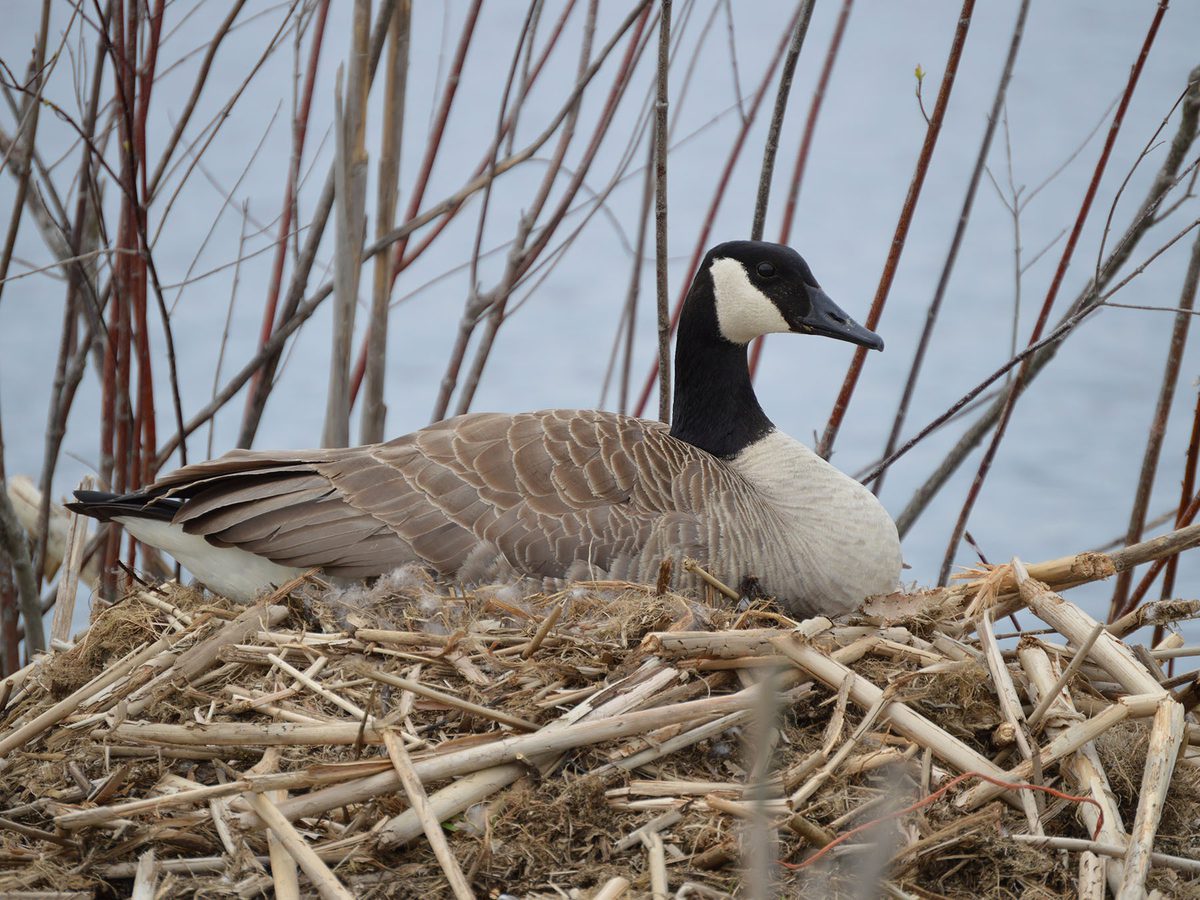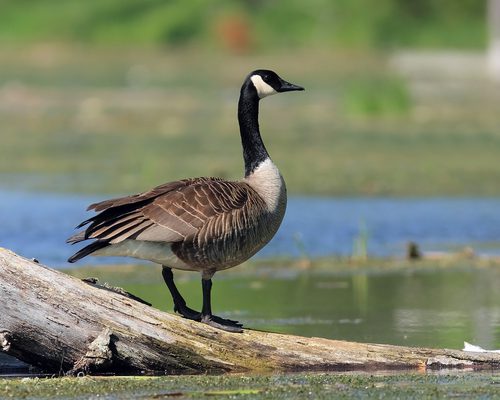One of the most well-known goose species in North America, Canada geese (Branta canadensis) breed across large areas of Canada and the northern and central United States. But with such a vast range, what kind of nest sites do Canadian geese prefer? And do they ever nest in trees? If you’d like to find out the answers – which may surprise you – then please keep reading!
Canada geese usually look for nest sites near to – or even surrounded by – water. Nests are frequently built on top of raised areas on the edges of ponds or on small islands. Only females incubate, but males remain close by to guard against predators.
Raised spots, such as on top of muskrat mounds or beaver dams, are often chosen as nest sites, as they offer a good all-round view of any approaching threats.
Waterside nest sites are important – as soon as they are able to walk (which is usually within 24 hours of hatching), young geese are led to a pond or lake where they swim and forage for food.
Our complete guide to Canada goose nesting has in-depth information about nest building, incubation times and brood size, so just read on to learn more.
| Key Canada Goose Nesting Facts | |
|---|---|
| Nesting season | April to August |
| Nesting material | Grasses, reeds, lichens, mosses, sticks, branches, feathers |
| Nest type | Bowl-shaped scrape, usually slightly raised |
| Nest location | Banks and edges near to water, sometimes on small islands |
| Number of broods | One brood |
| Clutch size | 2 - 8 eggs |
| Egg color | White, but can appear darker |
| Egg size | 56 mm x 83 mm |
| Egg weight | 163 g |
| Incubation period | 25 to 28 days, by the female |
| Fledgling period | 1 to 2 days after hatching usually |
| Reuse nests | No, but will use same locations |
| Use nest boxes | No |

A nesting pair of Canadian geese, with the female incubating on the eggs in the nest
Nest Location
Where do Canada Geese nest?
Canada geese nest on or near to the edges of wetlands or on small islands. Nest sites that offer good visibility in all directions are preferred, to increase the chance of spotting any approaching intruders. Arctic populations nest on the tundra, among the sedge vegetation.
Do Canada Geese nest in the same place every year?
Canada geese mate for life and will return to the same nesting location year after year. They will rebuild a nest in a similar spot to a previous successful nest, as it’s unlikely that an old nest will be in good enough condition to reuse for a second time.
Do Canada Geese nest in backyards?
Preferred nest sites of Canada geese are around the edges of wetlands or on small islands in lakes and ponds. They choose breeding spots where they can easily access water, and would be able to lead their young on foot to the water’s edge.
If your garden does fit this bill, then there is always a possibility that you’ll attract a breeding pair of Canada geese, as they are relatively tolerant of human company. It’s unlikely they’d breed in a traditional-sized urban backyard without a clear and visible route to a pond.

Canada Geese usually build their nests on the edge of wetlands
What trees do Canada Geese nest in?
Strange as it may sound, there are records of Canada geese setting up home in large tree nests that have been abandoned by species such as bald eagles. These are quite uncommon, as most Canada geese prefer a waterside ground level stick nest. But some pairs will have no qualms about using a higher altitude nest.
How high are Canada Goose nests?
Nests used by Canada geese are usually slightly elevated above the water’s surface, for example on top of a muskrat mound or on a pile of muddy debris.

Canada Goose nesting on a small island
Nest Appearance
What do Canada Goose nests look like?
Canada geese make nests on raised mounds near water, forming a bowl-shaped scrape in wetland vegetation, which is then built up with grasses, lichens, and any other plant material found nearby.
During incubation, the nest site may continue to be modified by the female, who will gradually add a lining of down around the eggs.
How big are Canada Goose nests?
Canada goose nests are large enough to support the brooding female as she incubates her egg. Nests measure between 30 and 100 cm (12 and 40 inches) in diameter.

Close up of a Canada Goose nest, with unhatched eggs inside
Phenology
What time of year do Canada Geese nest?
Timing of nesting depends a lot on geographical location, with Canada geese living at latitudes further north delaying breeding until May or June.
Geese living further south arrive on breeding grounds in early spring, and nesting behavior may be observed as early as March in some locations.
How long do Canada Geese nest for?
From starting the nest-building process to goslings, hatching can be anything between 30 and 37 days. Canada geese incubate their eggs for between 25 and 28 days.
What month do Canada Geese lay eggs?
Canada geese usually lay their eggs between March and June, although later breeding may be seen in higher latitudes, with pairs in Alaska recorded to routinely lay well into July.
Where do Canada Geese nest in the winter?
Nests are only used by Canada geese during the breeding season, and will not be used after the young have left.
In winter, many Canada geese head south, to wintering grounds in slightly warmer climates, and will spend their nights on water, as this offers the safest option to rest out of reach of predators.

Close up of a Canada goose sat on the raised nest, in a bed of reeds
Nest Construction
How do Canada Geese build their nests?
The nest site is chosen by the female Canada goose, who then constructs the nest alone while the male remains nearby and guards the site.
The female creates a shallow scrape in vegetation, which is then formed into a bowl-shaped nest using plant matter found around the nest location. Repairs and modifications continue after the eggs have been laid.
What do Canada Geese use for nesting?
Canada geese nests are made from plant matter, including grasses, reeds, lichens and mosses, as well as any sticks and branches that are available nearby. The female adds a lining of soft down around the eggs as incubation progresses.
Do male or female Canada Geese build the nest?
Building the nest is down to the female Canada goose, while the male remains nearby and sees off any predators that may attempt to approach the site.

A pair of Canadian geese looking for a suitable nesting location
Eggs
What do Canada Goose eggs look like?
Eggs of Canada geese are 5.6 cm (2.2 in) wide and 8.3 cm (3.3 in) long. They are creamy white in color, but may become stained by the vegetation used to build the nest.
How many eggs do Canada Geese lay?
A typical clutch laid by a Canada goose consists of between 2 and 8 eggs. After hatching, it’s not uncommon to see a pair of Canada geese with two or even three times as many goslings under their care.
It may blow your mind to think that they hatched all of them, but the likelihood is that they didn’t! Canada geese are a social species, and young are often raised by one set of parents in ‘gang broods’ of up to 100 goslings.
Do male Canada Geese sit on eggs?
Only female Canada geese incubate eggs and sit on nests. Males are never far away, and keep watch over their mate and their unhatched young, and once the goslings have hatched, family groups spend their days foraging together.

Close up of four unhatched Canada goose eggs inside of the nest
Fledgling and Parental Care
When do baby Canada Geese leave the nest?
After hatching, young goslings are ready to leave the nest within the first day or two, with the weather being a key factor. In poor weather, young Canada geese rely on the food in their yolk sack for up to two days before they need to leave the nest to forage.
How many broods do Canada Geese have?
In all but the most southerly populations, Canada geese are single-brooded. If a nest fails, a second brood may be attempted around 14 to 20 days later.

A family of Canadian geese - two adults with their goslings
FAQs
Do Canada Geese abandon their nests?
If a Canada goose nest fails, the pair will abandon the site, and depending on how late it is in the breeding season, an attempt at renesting at a new site may be made.
Do Canada Geese nest on the ground?
Canada geese nest at ground level, building nests that are slightly raised, giving them an unobstructed view of the surrounding area.

Young Canada goose chick (gosling)
Where do Canada Geese nest at night?
With the exception of females during incubation, Canada geese do not use nests at night. Instead, they sleep out on open water, safely out of danger from land predators.
How to attract nesting Canada Geese?
Canada geese look for two key factors when choosing a nest – easy access to water, and an unobstructed view in all directions. Adding decoy geese around the edges of a pond may attract passing geese to stop and check it out for themselves.
However, the species is considered an agricultural pest by some, due to extensive damage to grasslands by overgrazing and their vast amounts of poop.

